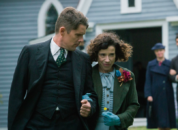
This rather sentimentalized biopic by Irish filmmaker Aisling Walsh based on the life of the Canadian folk artist Maud Lewis is essentially a wonderful vehicle that showcases the exceptional talent of British Oscar-nominee Sally Hawkins who steals very single scene.
Maud was born at beginning of the 20th century and suffered from rheumatoid arthritis, and when both her parents died when she was in her early 30’s her unscrupulous brother sold off the family home and Maud was shipped off to live with their maiden aunt in Nova Scotia claiming that she was unable to look after herself. Maud and Aunt Ida (Gabrielle Rose) did not get on at all, and with little other options open to her in the remote small coastal town of Digby, Maud answered an advert for a live-in maid by a local fish peddler Everett Lewis (Ethan Hawke.)
Everett a really grouchy 40 year old bachelor lived in a tiny unkempt house on a deserted part of the highway far outside of town. Although this was meant to be a housekeeping job, he treated Maud like an unpaid slave and he expected to share the only bed in the house too. He wasn’t slow to remind a nervous Maud about the pecking order of things ‘There’s me, them dogs, them chickens, then you.’
One day when tidying up the shack she came across a tin of paint and she used it to first to brighten up a shelf, before suddenly transferring the drab wooden walls into a one big canvass of flowers and trees. When she ran out of wall space to decorate, using other paints she found Maud started to paint postcards that she sold to the Village Store for a few cents each. These then progressed to slightly larger pictures of country scenes painted on off-cuts of wood, and when one day one of Everett’s fish customers paid an unexpected visit to their shack, and she spotted the pictures and insisted on buying one.
Sandra (Kari Matchett) was a wealthy part-time resident from NY who took a shine to both Maud and her naive paintings, and helped spread the word about them. Soon even the local television station were at the Lewis’s tiny shack filming Maud going about creating her art. By this time as Everett had wanted to take advantage of her in bed, she had insisted that they get married before she would let him. She had after all been harboring a dark secret of losing her virginity to another man when she was younger resulting in a baby that she had been told had been born dead with a hole in his heart.
The years had mellowed Everett who had grown quite fond of his wife, but others still never saw beyond his gruff exterior and he was so upset how he saw himself portrayed on the TV that it caused such a rift between him and Maud that she actually walked out. A rather reformed Everett found himself missing her so much, that completely out of character.
Hawkins version of Maud is not as physically deformed as the artist had been in real life, but she does however portray this determined physically challenged woman who will not let anything get in the way of her dreams and aspirations. It is a wonderful nuanced performance that serves to remind what a exceptionally talented actor she really is. The chemistry between her and Hawke is pitch perfect and makes their very unlikely relationship so utterly believable. Shot against the picture postcard vistas of this beautiful remote Nova Scotia coastline, also gave it such a rich visual panorama.
Purists will complain that it glamorized Maud’s real life that never rose from poverty, but it does at least accurately portray her position as one of most important Canadian folk artists of the last century.

